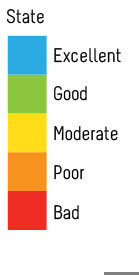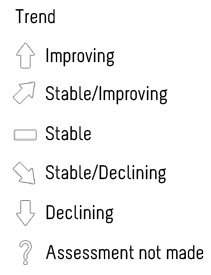| State of the environment 2014 |
On the whole, Scotland’s environment is of good quality |
| Air quality |
 |
State: Moderate
Trend: Stable / improving |
Our understanding of the sources and impacts of air pollution has improved over the years and applying it has led to better air quality in some areas. However, there are still areas in Scotland where poor air quality affects human health and the environment.
Datasets likely to be of interest
Air Quality in Scotland - datasets
Europa - Air quality datasets
NAEI - datasets
CEH - critical loads datasets
SEPA - SPRI datasets
Europa - datasets
Europa - indicators
|
| Coastal waters |
 |
State: Good
Trend: Stable / declining |
Almost all (97%) of Scotland’s coastal waters are in good or high condition, but there are local impacts from commercial fishing, aquaculture and diffuse pollution. Growth in industries such as aquaculture and renewable energy may increase pressure on coastal waters.
Datasets likely to be of interest
SEPA - Water environment hub
Europa - Nutrients in transitional, coastal and marine waters
|
| Estuaries |
 |
State: Good
Trend: Improving |
Scottish estuaries are important resources for wildlife and humans, and 85% are in good or high environmental condition. However, they remain under pressure from human activity, particularly from nutrient enrichment and the damaging impacts of climate change.
Datasets likely to be of interest
SEPA - Water environment hub
Europa - Nutrients in transitional, coastal and marine waters
|
| Freshwater lochs |
 |
State: Good
Trend: Stable / improving |
Scotland’s lochs are an important part of our landscape and provide water for drinking and power generation as well as space for recreation. They are generally in good condition.
Datasets likely to be of interest
SEPA - Water environment hub
DWQR - Annual report
Water Commission - Scottish water's annual return
Europa - Waterbase - water quality
|
| Rivers & canals |
 |
State: Moderate
Trend: Stable / improving |
Scotland’s river quality has improved in recent decades. Almost half of our rivers are now of good or better quality. Plans are in place to improve the remaining poorer-quality rivers.
Datasets likely to be of interest
SEPA - Water environment hub
SEPA - River water quality indicator
Europa - Waterbase - Rivers european data
|
| Rivers & lochs |
 |
State: Good
Trend: Stable / improving |
Scotland’s freshwaters provide a range of habitats for plants and animals. Overall, freshwater habitats and species are in good condition. However, while some individual habitats and species are improving, others are still under pressure.
Datasets likely to be of interest
Scotland's Environment - Protected nature sites
Europa - Indicators
|
| Crops & livestock |
 |
State: Moderate
Trend: Stable / declining |
Scotland produces a range of crops and livestock. Our agricultural industry provides the basic ingredients for our food and drink industry, and is important for our health, environment and economy – particularly in our rural communities.
Datasets likely to be of interest
Scottish Government - Agriculture, fisheries and rural publications
GOV.UK - Fertiliser usage
SASA - Pesticide usage
Europa - Indicators
|
| Farmland |
 |
State: Moderate
Trend:Stable / declining |
Scotland’s farmland is highly varied and contains a wide range of habitats for wildlife. However, populations of some birds and insects are in decline. Intensive land management is the main challenge to farmland wildlife.
Datasets likely to be of interest
Scottish Government - Agriculture, fisheries and rural publications
NatureScot - Breeding birds
Europa - Indicators
|
| Fossil fuels & minerals |
 |
State: Moderate
Trend: Stable |
Scotland has a wide range of geological resources that make a major contribution to the economy. They are used in the energy, construction and manufacturing industries and need to be carefully managed to ensure they are available for future generations.
Datasets likely to be of interest
GOV.UK - Minerals survey
|
| Mountains & uplands |
 |
State: Moderate
Trend: Stable / declining |
Scotland’s uplands contain our wildest places and some of our rarest plants and animals. The condition of many upland habitats is beginning to improve as action is taken to protect and manage them.
Datasets likely to be of interest
Scotland’s Environment - Protected nature sites
NatureScot - Breeding Birds
|
| Rocks & landforms |
 |
State: Good
Trend: Stable / declining |
Scotland’s rocks and landforms provide a range of benefits and help us to understand how the Earth has evolved. Our protected Earth science features are almost all in good condition, but we know little about the state of rocks and landforms outside protected sites.
Datasets likely to be of interest
BGS - Open Geoscience
|
| Soils |
 |
State: Good
Trend: Not assessed |
Scotland’s soils are diverse and rich in carbon; they are a vital natural resource providing a range of essential benefits and need to be protected. We have good information about some soil properties in some parts of the country. However, there is a lack of trend data.
Datasets likely to be of interest
Scotland’s Soils - National soils inventory for Scotland
Europa - Indicators
|
| Wetlands |
 |
State: Poor
Trend: Stable / declining |
Scotland’s wetlands are home to a wide range of plants and animals. They also provide important environmental functions such as storing carbon and sustaining the supply of clean water.
Scotland’s Environment - Scottish wetlands inventory
|
| Woodlands & forests |
 |
State: Moderate
Trend: Stable / declining |
Scotland’s woodlands and forests support a wide range of important plants and animals. For wildlife, our woodlands are in a moderately good condition now and are likely to improve in the future.
Datasets likely to be of interest
NatureScot - Breeding birds
Forestry Commission - Woodland statistics
|
| Cities, towns and greenspaces |
 |
State: Moderate
Trend: Stable / improving |
Most people in Scotland live in its towns, cities and city regions. A good-quality urban environment is a substantial factor in people’s health and well-being.
Datasets likely to be of interest
Scottish Government - Scotland’s outdoors national indicator
Scottish Government - Planning publications
|
| Energy |
 |
State: Poor
Trend: Improving |
Energy in Scotland is changing and will continue to do so as we strive towards a low carbon future.
Datasets likely to be of interest
GOV.UK - Total energy statistics
Europe: Indicators
|
| Historic environment |
 |
State: Moderate
Trend: Stable |
Scotland’s historic environment includes thousands of historic buildings and monuments, many of which are unique and irreplaceable. They attract millions of visitors every year and generate income and jobs.
Datasets likely to be of interest
HES - Spatial downloads
|
| Waste |
 |
State: Moderate
Trend: Stable / improving |
Waste is produced by households and businesses. Progress is being made to reduce waste and increase recycling in Scotland, providing environmental and economic benefits.
Datasets likely to be of interest
SEPA - Waste data reporting
Scotland’s Environment - Waste from all sources
Europa - Indicators
Europa - Statistics
|
| Climate |
|
State: Good
Trend: Rapidly changing |
Over the last 100 years it has become warmer, while altered precipitation patterns have led to drier summers, wetter winters and more frequent heavy rainfall. Changes in our climate over the next few decades are unavoidable because of the greenhouse gases already in the atmosphere. When viewed over long-term averages, we expect the UK to experience more milder wetter winters and more hotter drier summers in the future. These changes in climate and their effect on our weather will have major implications for our way of life.
Datasets likely to be of interest
Met Office - Datasets
UKCIP - Climate change projections (UKCP09)
Scottish Government - Environment publications
Europa - Indicators
|




















